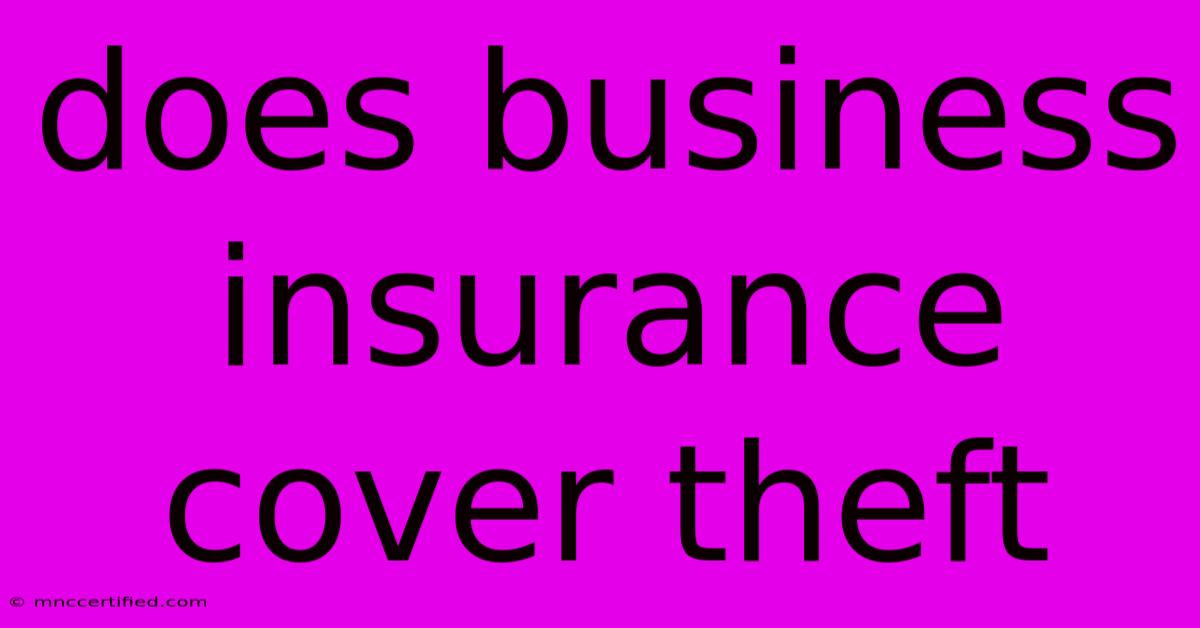Does Business Insurance Cover Theft

Table of Contents
Does Business Insurance Cover Theft? A Comprehensive Guide
Theft is a significant risk for businesses of all sizes, from small startups to large corporations. Whether it's shoplifting, employee theft, or a break-in, the financial consequences can be devastating. This leads many business owners to wonder: does business insurance cover theft?
The short answer is: it depends. While most business insurance policies include some form of coverage for theft, the specifics vary greatly depending on the type of policy, your specific coverage, and the nature of the theft.
What Types of Business Insurance Cover Theft?
Several types of business insurance policies can provide coverage for theft. Here are some of the most common:
- Commercial Property Insurance: This policy protects your business property, including inventory, equipment, and furniture, against various perils, including theft. It typically covers both the cost of replacing stolen items and any damages caused during the theft.
- Business Owners Policy (BOP): A BOP combines several types of insurance, including property and liability coverage, into a single policy. It often includes theft coverage for your business property.
- Crime Insurance: This specialized policy specifically covers financial losses resulting from criminal activity like theft, embezzlement, and forgery. It can provide protection for various types of losses, including cash, securities, and property.
- Workers' Compensation Insurance: While not directly covering theft, Workers' Compensation insurance can help cover medical expenses and lost wages if an employee is injured during a robbery or other theft-related incident.
What is Typically Covered?
The specific types of theft covered by business insurance vary depending on the policy and the specific endorsements you have. Here are some common situations covered:
- Shoplifting: If a customer steals merchandise, your insurance policy may cover the loss of the stolen goods.
- Employee Theft: If an employee steals cash, inventory, or other assets, your policy might cover the loss.
- Burglary or Break-In: If someone breaks into your business and steals property, your insurance can help cover the stolen items and any damage caused during the break-in.
- Data Theft: Some policies may offer coverage for data breaches, which can include stolen customer information and sensitive business data.
What is Not Typically Covered?
While business insurance can protect against theft, it doesn't cover everything. Some common exclusions include:
- Losses caused by dishonest acts of business owners or partners: This is typically covered by a separate fidelity bond.
- Theft from unattended vehicles: These losses are usually covered by a separate auto insurance policy.
- Intentional theft by employees: If your employee knowingly steals from the business, your policy may not cover the loss.
What to Do if You Experience a Theft
If your business is the victim of theft, follow these steps:
- Contact the authorities immediately: Report the theft to the police and provide detailed information about what was stolen and any evidence you have.
- Document the theft: Take photographs of the scene, any damage caused, and missing items. Collect any receipts or invoices for stolen goods.
- Contact your insurance company: Inform your insurance company about the theft and provide them with the necessary documentation. Follow their instructions for filing a claim.
Understanding Your Business Insurance Coverage
It's essential to thoroughly review your business insurance policy and understand the specifics of your coverage for theft. Ask your insurance agent about:
- The specific types of theft your policy covers: Ensure you have coverage for the types of theft most likely to affect your business.
- The policy's limits and deductibles: Understand how much you're responsible for paying before your insurance kicks in.
- Any exclusions or limitations: Be aware of any situations where theft may not be covered.
Key Takeaways
While business insurance can provide vital protection against the financial impact of theft, it's not a magic bullet. By understanding the specifics of your coverage and taking steps to mitigate your risk, you can better protect your business from the devastating consequences of theft.

Thank you for visiting our website wich cover about Does Business Insurance Cover Theft. We hope the information provided has been useful to you. Feel free to contact us if you have any questions or need further assistance. See you next time and dont miss to bookmark.
Featured Posts
-
Insurance Direction Of Payment Form
Nov 13, 2024
-
Uk Nhs Launches New Smoking Cessation Pill
Nov 13, 2024
-
Pistons Edge Heat In Overtime Thriller
Nov 13, 2024
-
Does Car Insurance Cover Lost Wages
Nov 13, 2024
-
Arthur Krenzel Lett Insurance Group
Nov 13, 2024